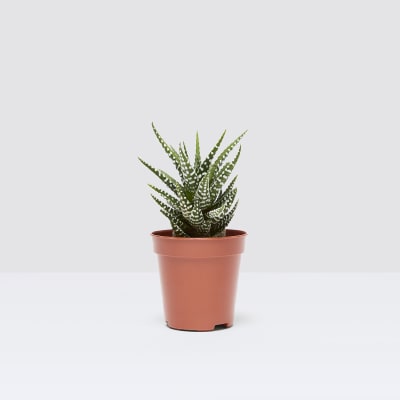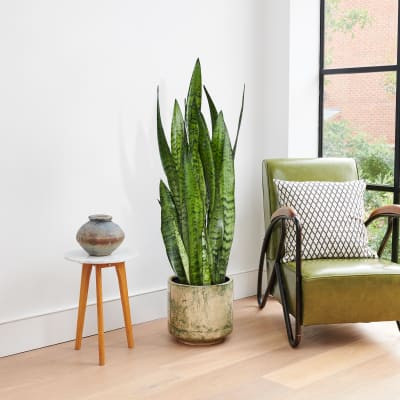

From £4.00


From £4.00
Out of stock
See optionsPropagation is the method of growing new plants from existing ones. It’s a great way to understand your plants better, see them grow, and share cuttings with friends. Spring and summer are the best times to help your plant have babies, as your plant is likely to be in its active growing period.
There are a few different propagation methods, so start by searching for tips on propagating your particular plant. The three main ways to propagate your plants are cutting, division, and replanting of offsets.
Taking a cutting and replanting it creates an exact clone of the original plant. It relies on the amazing ability of some plants to produce roots from the bottom of a cut stem or leaf.
Division involves splitting a parent plant into sections, each of which can be replanted as a separate plant. Finally, some plants grow miniature versions of themselves called offsets. These can be removed and replanted to grow on their own.
Cutting off part of a plant’s stem or a leaf and replanting can create an exact clone of the original plant. Rapunzel and Chaz can both be propagated with stem cuttings, whereas leaf propagation works for Suri and Susie. 🌱
Start by making a container where your cutting will live while it grows roots. Stem propagation requires deeper pots, but leaf propagation can be done in a shallow tray. Don’t use a multipurpose potting soil for propagation, it’s best to use a soil mix optimised for propagation, usually referred to as a ‘rooting medium’, rather than a multipurpose potting soil. Check online for suggestions for a soil mix that will work for your plant. Some need to contain extra sand or Perlite, for example.
Next you can take your leaf or stem cutting. Stem cuttings should be taken from a few centimeters below a node (where the stem and leaf meet) using a sharp pair of scissors. The stem should have a good few nodes above the point of cutting. Leaf cuttings are different. For succulents, remove the entire healthy leaf down to the stem with your fingers. If you’re using Susie, cutting the top section of the leaf will be enough.
Stem cuttings should be placed immediately into the rooting medium to keep the cut edge moist. Submerge them into the rooting medium just far enough so that it holds them up. When it comes to leaf cuttings, fleshy leaves usually need to be left for a couple of days to develop a callus over the cut edge. Others can go straight into the rooting medium, with at least some of the cut edge of the leaf touching the soil. Sansevieria needs the whole of the cut edge to be placed into the soil.
Stem cuttings should now be misted and sealed in their container. Leaf cuttings can be left uncovered but should be placed somewhere warm, with indirect light. Make sure the rooting medium remains moist by misting whenever it feels dry. It will take a couple of months to see your new plants forming, but once you see roots you can cover them with a bit of soil to keep the growth going.
To see this method in practice check out this video: https://www.youtube.com/watch?v=cK3Qg2mGYAg
Plants that have separate stems, or grow in clusters, can be propagated by dividing the original plant into sections. Each one can then be replanted separately, and allowed to continue growing as a single plant. Plants that can be propagated in this way include Juliette, Howard, Bertie and Venus, Susie, Zey and some succulents.
Start by preparing the pots that your divided plants will be planted into. You can divide the plant into as many sections as possible, or just separate off a small section from the original - totally your call.
Dividing plants is messy work, so lay out lots of newspaper or set yourself up outside. Remove the original plant from its pot and massage the roots to figure out how easily they will separate. Once they’ve been divided you can repot your new sections into your waiting pots and top up with fresh compost.
If you’ve ever seen your plant growing miniature versions of itself, you’ll know what we’re talking about when we mention offsets. These are small replicas of a parent plant that can be removed and replanted.
Don’t be too hasty with offsets - they shouldn’t be removed until they can live independently from the parent plant. As before, have your new pot ready before removing the offset.


From £10.00
Out of stock
See options

From £10.00
Out of stock
See options
Free standard delivery on orders over £50
Need to get in touch?
Just use the help widget to send a message to the team.
Customer service opening hours:
Monday to Sunday 9am-7pm
Live chat is available 10am-7pm Monday to Friday
Secure payment - our systems are protected with bank-grade security. Your payment is safe with us.
We work directly with over 40 specialist growers to bring you the best quality plants
If you need advice, just get in touch - we’ll be your personal plant gurus as long as you need us. If something’s up, tell us within 30 days of delivery — we’ll sort it.
We usecookiesto improve your experience on our site.